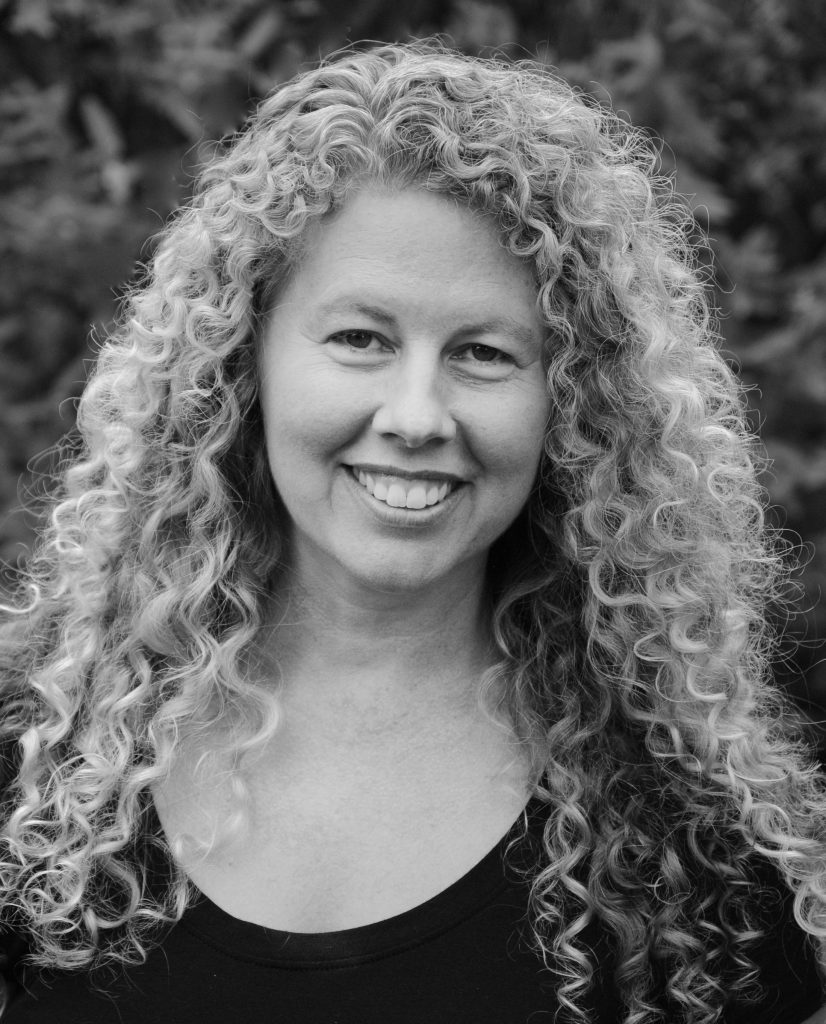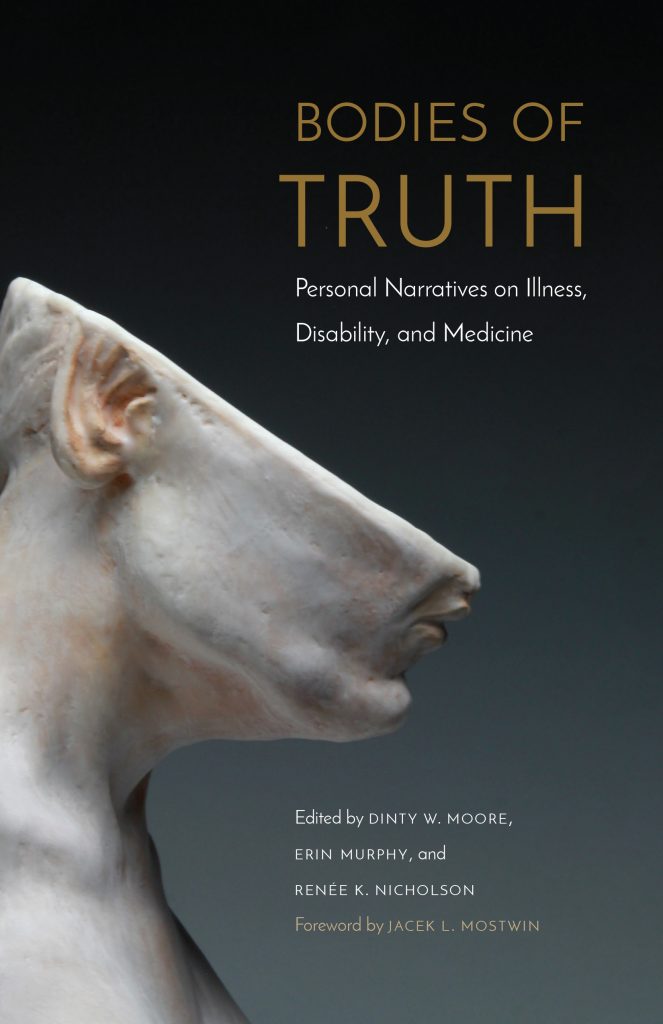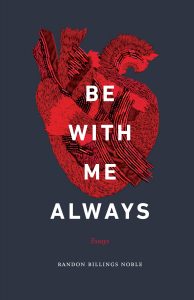
Photo by Greg Ellis/WVU

Photo by Molly De Prospo

The anthology Bodies of Truth, edited by Dinty W. Moore, Erin Murphy, and Renée K. Nicholson, contains twenty-five nonfiction works that range from flash memoir to meditation, lyric essay and epistolary, that interrogate and explore the writers’ experiences with illness, disability, and medicine in the contemporary healthcare system in the United States.
The essays in this anthology contribute to the discourse of narrative medicine, a movement in medical education that aims to balance the clinical side of medical practice with the very human aspect of storytelling, bringing the voices of patients and physicians to the forefront of understanding the subjective experiences of illness. As mentioned in the Foreword, by Jacek L. Mostwin, and the Preface, this book serves as an accessible resource for medical professionals as they engage with and learn more about narrative medicine.
However, this anthology can also serve as a resource for nonfiction writers to expand their own practice on narrative, more broadly. Each piece in the collection, which the editors call “personal narratives,” provides strategies on how to tell a powerful story briefly and how to find language for what feels impossible to describe.
This interview was conducted with editors Erin Murphy and Renée K. Nicholson by S. Ferdowsi via email and has been edited for length and clarity.
Punctuate.:In your Preface, you mention you all live and work in Appalachia where you engage with rural medical communities and I was wondering how that led to this anthology?
Erin Murphy:From 2010-12, I led a medical humanities discussion group at what is now UPMC Hospital in Altoona, Pennsylvania. The group was a mix of resident and longtime physicians, and we read texts that were 300-500 pages long. I found that most of the doctors were so busy that they would only have time to read the first few pages. Even so, we could spend an hour talking about a single issue or detail from a book. It occurred to me that there was a need for a collection of short works that could be read in a single sitting, even during a coffee break. So I contacted Renée and Dinty, both of whom had experience and interest in narrative medicine, and asked them to work on this anthology project with me.
Renée K. Nicholson:My first inspiration is my brother, Nate, who is a metastatic cancer patient. I wanted a book to be out there that could help him feel not so alone. As well, I’d been writing with patients with conditions as different as ALS and Cancer, and started working with professionals from West Virginia University’s Health Sciences Center with a variety of projects with patients, students, professors and clinicians. The book allows me to have a resource for this very wide variety of people interested in or connected by illness, disability, and medicine. So, when Erin invited me to work with her and Dinty, it was a natural fit for me. I also think that working with patients in West Virginia, in the heart of Appalachia, reminds me how much story is a part of this culture. And that reminds me that story is part of just about all cultures. By creating this anthology, in some way I think we honor our storytelling impulse.
Punctuate.:Can you describe your experience putting together an anthology?
RKN:Because I’d never put together an anthology before, I felt that Erin and Dinty really guided me and mentored me through the process. What I learned just from this was that you want co-editors you like, trust, and respect, because you’re all working closely together. If you’re new, like me, try to learn as much as you can while also contributing.
We solicited essays from people we knew or knew of first, and because together we found the breadth and depth we needed, we didn’t put out a call. We kept good records of what we got in terms of essays, and then we each read and commented. Often, we’d have an email chain of thoughts—not just on the essays themselves, but also on issues like making sure we had diversity in both subjects and authors, looking at the balance of patients, caregivers, clinical professionals, and so on. We wanted diverse voices in terms of race and ethnicity as well. I suppose a good anthology is like a good diet—very balanced.
Also, not all of our selections were from those who consider themselves professional writers, and we saw this as one of the collection’s strengths. Sometimes, though, we’d have to walk through some edits, and so usually the editor closest to the writer would take the lead there. I think the process built a lot of trust, between the three editors as well as between us as editors and the writers in the anthology.
Punctuate.:If any of our readers are working on their own anthologies, what advice would you give to them?
EM:This is the third anthology that I’ve edited. What my co-editors and I have done with each book is to put together a dozen or so chapters to send to prospective presses with our proposal. Then once we receive a preliminary contract, we solicit the remaining works. All told, it typically takes about three years from start to finish.
RKN:If you are a first time anthology editor, I would say be prepared to put in the time to do a thorough job. Work with experienced editors if you can. I learned so much from Erin and Dinty as a part of the process of putting this one together.
Punctuate.:Many of the essays detail heavy subject material—the pain that comes from chronic illness and drug addiction; the stress that comes with expensive medical treatments; witnessing your children or fellow patients living with mental, physical, or intellectual disabilities and feeling unable to help—and I found myself feeling veryemotional as I read the anthology. I’m wondering if you had a similar experience from an editor’s vantage point and if you employed any strategies to make it through this process? How does handling tough subject material look like for an editor?
RKN:Any time you are dealing with serious illness, it can be important to have those things that give you a break or release. At the time I was working on the anthology, I was actively working with patients in clinics at WVU Medicine, and supporting my family as my brother went through treatments for cancer. So, for me, there were layers of things going on at the same time.
On the one hand, the book and the essays within it helped me feel as if I was not alone—the work itself made for connections and community. Sometimes, however, I would need to clear my mind to allow it to process everything. For me personally, one of the best “breaks” would be to take my golden retriever for a walk. The physical exercise and my dog’s friendly, sweet disposition allowed me those moments of release. I’d say that honoring the stories includes stepping back when you need to clear your mind and let the emotions settle. I will also say that it helps me understand issues in medicine like burnout and compassion fatigue. Health professionals often confront the tough situations, and I can see where they would need, just as I needed, times of calm, comfort, and joy.
Punctuate.:Despite the heavy subject material, I also noticed that some essays do inspire hope. I’m specifically thinking of “A Measure of Acceptance” that shows the unexpected resourcefulness and creativity Floyd Skloot gains when learning how to live with his neurological illness and “Overtones” where Meredith Davies Hadaway transforms her own grief from losing her husband into supporting others through music therapy. Did you intentionally look for essays with “happy-ish” endings, or did those emerge organically through your search?
EM:We deliberately sought a range of subject matter and tones, partly because it makes for a richer reading experience and partly because the range reflects the highs and lows of the medical experience. You can be in your darkest hour and sometimes in spite of—or maybe even because of—the stress, you can find yourself laughing at the ridiculousness of a situation. We wanted the book to mirror these peaks and valleys to some extent.
RKN:The range that Erin spoke about is very important. Illness, disability, and medicine includes things like hope, like joy, even humor. Medicine encompasses the whole range of human emotion, and capturing many of them, especially surprising ones, were part of the process of finding and choosing work.
Punctuate.:I’m very intrigued by how “narrative” works in the anthology. In the Foreword, Jacek L. Mostwin writes that “narrative medicine” is a movement that restores the patient’s and physician’s voices back into medicine, and then links this to the oral tradition of the Ancient Greeks. How do you see “narrative” as a literary device working through and across all the essays?
RKN:Currently, I’m finishing up a Professional Certificate in Narrative Medicine through Columbia University. The program was created by a general internist and PhD in Literature named Dr. Rita Charon, who wrote, “The care of the sick unfolds in stories.” One of the things we explore in the coursework and in the anthology is the idea that the stories that come out of medical situations are often multi-vocal. The anthology emerges from this idea of the multi-voiced experience of illness or disability. Giving voice or narrative structure to experiences within medicine allows us to feel less passive in the process. By reading these accounts, we gain the opportunity to recognize, absorb, interpret and be moved by the stories of others. Perhaps those who read these will be moved to write or express their own narratives. Sure, that can be for publication, but it can also just be for a single person to have a better understanding of him or herself, or to share with others in many ways. I see narrative approaches as a way to enhance the medical encounter, to help the patients feel heard and understood, and help clinicians connect with those they serve. I don’t know that we can teach empathy, but we can give people the opportunity to use the empathy within them, and to practice empathy. Narratives like the ones we’ve collected in the anthology offer those opportunities to use and practice empathetic skills. It gives us the occasion to reflect.
Punctuate.:At the end of “Two Hearts,” an essay about his son’s heart defect, Brian Doyle writes “this is where our conversation always ends…” and I’m wondering if you see a relationship between a “narrative” and a “conversation.” For example, in the news, people are always talking about having a “conversation” on gun violence, or race, or sexual assault, but then it never feels like we actually go into that conversation. So, I’m wondering what you think a narrative can accomplish that a conversation can’t and vice versa.
EM:That’s an interesting question. I suspect the media has twisted the meaning of conversation to meet its needs, much as Facebook has co-opted the word “friend.” In one sense, the narrative is a one-sided conversation. We hope, though, that by engaging with each narrative that readers will continue the conversation, either in their own lives, their classrooms, or their practices.
RKN:To echo what Erin says, I believe these stories encourage a continuation of the conversation. Maybe that conversation is with others, and sometimes that’s a conversation with the self. I’ll go back to the idea of reflection. These narratives invite us into someone else’s experiences, and when we read them, we’re implicitly invited to reflect on our own experiences, thoughts, and feelings. In turn, this reflection allows us to better navigate ambiguities.
Punctuate.:University of Nebraska is gaining a reputation of publishing really innovative, experimental and unconventional collections. How was it like working with a university press?
EM:We were thrilled that the University of Nebraska Press accepted this anthology because, like you say, they are publishing innovative collections. Some of my favorite books are from their list. They have a terrific team of editors and marketing staff who not only support you in producing a high-quality book but also do their best to promote it once its published. Every time I turn around, there’s an ad for Bodies of Truthin a major publication, a conference program, or a catalog.
RKN:Like Erin, many of my favorite books are from the University of Nebraska Press list. Erin said it well—just a terrific team that provides great support and promotion.
Punctuate.:How did your own personal backgrounds in poetry, nonfiction, and dance shape your understanding of illness and the process of putting this anthology together?
EM:I wrote both poetry and creative nonfiction, and I find that there is a lot of overlap between the two. In narrative medicine—as with poetry—you are looking for the precise image or detail to bring a large experience down to a small size for the reader. An author isn’t writing about everyone with cancer—she’s writing about her experience, and maybe even just a single day or moment of that experience. What’s left out is just as important as what’s included, and this applies both to the writing and the editing process. While my creative writing influenced my work on the anthology, I should add that my interest in narrative medicine has also carried over to my creative work. For example, my most recent poetry collection, Assisted Living(Brick Road Poetry Press, 2018), focuses on caregiving and end-of-life issues.
RKN:I trained in classical ballet, and when that career was sidelined by rheumatoid arthritis, I turned to writing. In many ways working on the anthology feels like a natural extension of that. Illness can be a burden, and yet one that can offer opportunities, especially for expression. One of our essays spoke to me because I recognized it as being about rheumatoid arthritis specifically. There was the “I knowthis” feeling reading it. And even though each person experiences illness in his or her own way, there can be a strong feeling of connection. All the pieces invited us into unique experiences and also allowed for touchpoints where we feel connected.
Punctuate.:Tell me a little bit about your title, Bodies of Truth.I am fascinated by how the essays all come together and demonstrate this tricky thing between the subjective experience of being in a body and this concept of “Truth” that is an absolute.
RKN:The word “bodies” conjures up many interpretations. There is the somatic sense of the body, this vessel separate from the mind. There is the idea of a body as a group with a common purpose or goal. Body can also be the central part of something, like a text. I love all these interpretive layers of body when thinking of the title Bodies of Truth. In each body of each essay, there’s a truth. In this body of essays about bodies, there are truths. Like many truths, the ones shared in these pieces are hard earned and yet often elusive. And there, hopefully, are new truths found and explored as people read the book.
Interview by S. Ferdowsi
___________________________
Bio: S. Ferdowsi is a writer based in Chicago working on her first manuscript.


